Catchment Storage Command Relationship for Sustainable Rainfed Agriculture in the Semi-Arid Regions of Rajasthan, India
Abstract
:1. Introduction
1.1. Statement of the Problem
1.2. Genesis and CSC Concept
1.3. Definition of Drypell
1.4. Review of Literature
1.5. Limitations of Rainwater Managment
1.6. Climate Change Impact on Rainfed Crops
- To establish a rainfall–runoff relationship and design a rainwater-harvesting structure in the form of a farm pond for threshold storage.
- To develop a water use strategy for supplemental irrigation to enhance water productivity with diversified farming systems.
2. Materials and Methods
2.1. Study Hypothesis and Conceptualization
2.2. Study Area and Climate
2.3. Site Description
2.4. Land Use Landcover
2.5. Rainfall and Runoff Data Recording
2.6. Rainwater Utilization Strategy in Enhancing the WP of a Diversified Farming System in Kharif
2.7. Rainwater Utilization Strategy in Enhancing WP of the Diversified Farming System in Rabi
2.8. Irrigation Schedule
2.9. Statistical Analysis
3. Results and Discussion
3.1. Rainfall Pattern and Supplemental Irrigation
3.2. Rainfall Runoff Relation
3.3. Design of Threshold Storage
3.4. Rainwater Utilization Strategy in Enhancing the WP of a Diversified Farming System in Kharif
3.4.1. Effect of Supplement Irrigation on Crop Yield
3.4.2. Effect of Supplement Irrigation on System Water Use Efficiency
3.4.3. Effect of Supplemental Irrigation on Yield and Economics of Kharif Vegetables
3.5. Rainwater Utilization Strategy in Enhancing the WP of Diversified Farming System in Rabi
3.5.1. Effect of Supplemental Irrigation on Yield and Productivity of Rabi Vegetables
3.5.2. Effect of Supplemental Irrigation on the Economics of Rabi Vegetables
3.6. Limitations of the Study
- A small category of farmers only can adopt this system, and 2–4% of farmland will be lost to the RWH structure.
- The cost of excavation, including cement concrete lining.
- The results obtained are location/site specific.
- Evaporation losses were not accounted here.
4. Conclusions
- Based on the results and discussion, in semi-arid regions of Rajasthan, India, with an average annual rainfall of 657 mm in clay loamy soils (ustochrepts), an agricultural catchment of 2.0 ha is able to harvest a threshold volume in the range of 700–1700 m3, depending on seasonal rainfall. This water can be stored in a RWH structure (farm pond) of a capacity of 560 m3 by considering/assuming at least three fillings occur in monsoon season.
- A farm pond of a capacity of 560 m3 can accommodate, even if there is minimum runoff on average and below-average rainfall years and maximum runoff in a wet year where the rainfall receives more than average.
- Harvested rainwater can be efficiently utilized through drip irrigation to a command area of 1.0 ha in both the seasons (kharif and rabi) by providing a supplemental irrigation of 5 cm in each season under a normal rainfall situation for dominant crops in the regions like maize and vegetables (coriander).
- Regular desilting of the farm pond will be required to maintain a designed storage, and the silt material can be applied to crop fields of the command area, which in turn enriches the nutrients.
- In the semi-arid tropical region of Rajasthan, India, with a farming situation of loamy soils, a catchment of 2.0 ha of agricultural micro watershed can be stored in a RWH structure (farm pond) of a capacity of 560 m3 and can be able to supply an irrigation of 5 cm to a command area of 1.0.
Author Contributions
Funding
Institutional Review Board Statement
Informed Consent Statement
Data Availability Statement
Conflicts of Interest
Appendix A
| S. No. | Treatment | Water Productivity (kg/m3) | B:C Ratio | ||||||||
|---|---|---|---|---|---|---|---|---|---|---|---|
| 2011 | 2012 | 2013 | 2014 | Mean | 2011 | 2012 | 2013 | 2014 | Mean | ||
| Rabi crops | |||||||||||
| 1 | Coriander green | 1.58 | 1.27 | 1.39 | 1.79 | 1.51 | 6.68 | 4.68 | 3.18 | 2.37 | 4.23 |
| 2 | Pea pod | 1.5 | 1.5 | 1.3 | 1.17 | 1.37 | 5.77 | 4.69 | 2.79 | 1.29 | 3.63 |
| 3 | Brinjal | 0.78 | 0.86 | 0.84 | 1.37 | 0.96 | 3.36 | 3.7 | 2.35 | 1.47 | 2.72 |
| 4 | S.E m± | 0.12 | 0.35 | ||||||||
| 5 | C.D at 5% | 0.41 | NS | ||||||||
| CV(%) | 18.39 | 19.82 | |||||||||
| 6 | Surface irrigation | 0.82 | 0.94 | 0.94 | 0.87 | 0.89 | 4.43 | 3.49 | 2.39 | 1.24 | 2.89 |
| 7 | Drip irrigation | 1.75 | 1.43 | 1.6 | 2.02 | 1.70 | 6.11 | 4.66 | 3.42 | 2.18 | 4.09 |
| 8 | S.E m± | 0.10 | 0.12 | ||||||||
| 9 | C.D at 5% | 0.46 | 0.53 | ||||||||
| CV(%) | 15.90 | 6.70 | |||||||||
| S. No. | Treatments | Water Productivity (kg/m3) | B:C Ratio | ||||||||||
|---|---|---|---|---|---|---|---|---|---|---|---|---|---|
| 2009 | 2010 | 2011 | 2012 | 2014 | Mean | 2009 | 2010 | 2011 | 2012 | 2014 | Mean | ||
| 1 | Sponge gourd | 0 | 3.34 | 3.2 | 2.63 | 2.18 | 2.27 | 0 | 2.95 | 4.42 | 3.71 | 2.65 | 2.75 |
| 2 | Bottle gourd | 3.99 | 2.93 | 3.32 | 3.11 | 2.27 | 3.12 | 2.11 | 2.7 | 4.75 | 4.48 | 3.36 | 3.48 |
| 3 | Ridge gourd | 6.01 | 5.6 | 2.92 | 3.16 | 2.07 | 3.95 | 2.88 | 3.69 | 3.82 | 4.59 | 2.94 | 3.58 |
| 4 | Kachari (cucumber) | 7.84 | 7.84 | 6.46 | 4.74 | 3.56 | 6.09 | 4.09 | 5.49 | 6.53 | 6.17 | 5.34 | 5.52 |
| 5 | Veg cow pea | 3.66 | 6.2 | 4.33 | 4.42 | 2.77 | 4.28 | 1.62 | 3.8 | 3.81 | 4.8 | 3.28 | 3.46 |
| S.Em± | 0.54 | 0.25 | |||||||||||
| C.D (at 5%) | 1.63 | 0.75 | |||||||||||
| CV (%) | 30.78 | 14.81 | |||||||||||
| 1 | Surface irrigation (5 cm) | 2.7 | 3.46 | 2.45 | 4.36 | 2.02 | 3.00 | 1.97 | 3.51 | 4.33 | 4.36 | 3.15 | 3.46 |
| 2 | Drip irrigation (5 cm) | 5.9 | 6.91 | 5.64 | 4.7 | 3.12 | 5.25 | 2.31 | 3.95 | 5.01 | 4.7 | 3.88 | 3.97 |
| S.Em± | 0.45 | 0.06 | |||||||||||
| C.D (at 5%) | 1.78 | 0.23 | |||||||||||
| CV (%) | 24.53 | 3.56 | |||||||||||
| 1 | Sole maize (irrigated) 5 cm | 0 | 5.56 | 5.83 | 5.83 | 3.59 | 4.16 | 0.22 | 3.99 | 3.77 | 4.57 | 2.17 | 2.94 |
| 2 | Sole maize unirrigated | 0 | 3.34 | 3.2 | 2.63 | 2.18 | 2.27 | 0.55 | 4.29 | 3.28 | 3.69 | 1.75 | 2.71 |
| S.Em± | 0.39 | 0.17 | |||||||||||
| C.D (at 5%) | 1.54 | NS | |||||||||||
| CV (%) | 27.32 | 13.23 | |||||||||||
| Normal seasonal rainfall (mm) | |||||||||||||
| Actual seasonal rainfall (mm) | 306.8 | 593.0 | 509.7 | 963.8 | 521.6 | ||||||||
References
- Government of INDIA, Department of Agriculture and Farmers Welfare. 2022. Available online: https://agriwelfare.gov.in (accessed on 23 July 2022).
- Keatinge, G. Agricultural Progress in Western India; Longmans, Green and Co.: New York, NY, USA, 1922; Volume 110. [Google Scholar]
- Kumar, S. Does “Participation” in Common Pool Resource Management Help the Poor? A Social Cost-Benefit Analysis of Joint Forest Management in Jharkhand, India. Dev. Crit. Essays Hum. Geogr. 2002, 30, 295–314. [Google Scholar] [CrossRef]
- Sharda, V.N.; Shrimali, S.S. Water Harvesting and Recycling in Northern Hilly Regions. Indian J. Soil Conserv. 1994, 22, 84–93. [Google Scholar]
- Samra, J.S. Water Harvesting and Recycling: Indian Experiences; Central Soil & Water Conservation Research & Training Institute: Dehra Dun, India, 2002; 347p. [Google Scholar]
- Barron, J.; Rockström, J.; Gichuki, F.; Hatibu, N. Dry Spell Analysis and Maize Yields for Two Semi-Arid Locations in East Africa. Agric. For. Meteorol. 2003, 117, 23–37. [Google Scholar] [CrossRef]
- Raghavan, K. Break-Monsoon Over India. Environ. Sci. Mon. Weather Rev. 1973, 101, 33–43. [Google Scholar] [CrossRef]
- Boers, T.M.; Zondervan, K.; Ben-Asher, J. Micro-Catchment-Water-Harvesting (MCWH) for Arid Zone Development. Agric. Water Manag. 1986, 12, 21–39. [Google Scholar] [CrossRef]
- Bruins, H.J.; Evenari, M.; Nessler, U. Rainwater-Harvesting Agriculture for Food Production in Arid Zones: The Challenge of the African Famine. Appl. Geogr. 1986, 6, 13–32. [Google Scholar] [CrossRef]
- Fox, P.; Rockström, J. Supplemental Irrigation for Dry-Spell Mitigation of Rainfed Agriculture in the Sahel. Agric. Water Manag. 2003, 61, 29–50. [Google Scholar] [CrossRef]
- Hatibu, N.; Young, M.D.B.; Gowing, J.W.; Mahoo, H.F.; Mzirai, O.B. Developing Improved Dryland Cropping Systems for Maize In Semi-Arid Tanzania. Part 1: Experimental Evidence for The Benefits of Rainwater Harvesting. Exp. Agric. 2003, 39, 279–292. [Google Scholar] [CrossRef]
- Motsi, K.E.; Chuma, E.; Mukamuri, B.B. Rainwater Harvesting for Sustainable Agriculture in Communal Lands of Zimbabwe. Phys. Chem. Earth 2004, 29, 1069–1073. [Google Scholar] [CrossRef]
- Barron, J.; Okwach, G. Run-off Water Harvesting for Dry Spell Mitigation in Maize (Zea Mays L.): Results from on-Farm Research in Semi-Arid Kenya. Agric. Water Manag. 2005, 74, 1–21. [Google Scholar] [CrossRef]
- Liu, F.; Wu, Y.; Xiao, G.; Gao, Q. Rainwater-Harvesting Agriculture and Wateruse Efficiency in Semi-Arid Regions in Gansu Province, China. Outlook Agric. 2005, 34, 154–165. [Google Scholar] [CrossRef]
- Adekalu, K.O.; Balogun, J.A.; Aluko, O.B.; Okunade, D.A.; Gowing, J.W.; Faborode, M.O. Runoff Water Harvesting for Dry Spell Mitigation for Cowpea in the Savannah Belt of Nigeria. Agric. Water Manag. 2009, 96, 1502–1508. [Google Scholar] [CrossRef]
- Glendenning, C.J.; Babu, S.; Asenso-Okyere, K. Review of Agricultural Extension in India. Are Farmers Information Needs Being Met; International Food Policy Research Institute (IFPRI): Washington, DC, USA, 2010. [Google Scholar]
- Liu, J.; Tan, J.; Zhang, S.; Zhong, C.; Lv, L.; Tara, A. Suitability Assessment of Small Dams’ Location as Nature-Based Solutions to Reduce Flood Risk in Mataniko Catchment, Honiara, Solomon Islands. Sustainability 2023, 15, 3313. [Google Scholar] [CrossRef]
- Sanfo, S.; Barbier, B.; Dabiré, I.W.P.; Vlek, P.L.G.; Fonta, W.M.; Ibrahim, B.; Barry, B. Rainfall Variability Adaptation Strategies: An Ex-Ante Assessment of Supplemental Irrigation from Farm Ponds in Southern Burkina Faso. Agric. Syst. 2017, 152, 80–89. [Google Scholar] [CrossRef]
- Ali, S.; Sethy, B.K.; Parandiyal, A.K.; Kumar, A.; Singh, R.K.; Somasundaram, J.; Mina, B.L. Long-Term Effects of Rainwater Conservation Measure on Improving Yield, Runoff Use Efficiency and Soil Properties of Horti-Pastoral System on the Degraded Ravine Lands of India. Agric. Water Manag. 2020, 233, 1060–1068. [Google Scholar] [CrossRef]
- Oweis, T.; Hachum, A. Water Harvesting and Supplemental Irrigation for Improved Water Productivity of Dry Farming Systems in West Asia and North Africa. Agric. Water Manag. 2006, 80, 57–73. [Google Scholar] [CrossRef]
- Rao, C.A.R.; Rao, K.V.; Raju, B.M.K.; Samuel, J. Levels and Determinants of Economic Viability of Rainwater Harvesting Farm Ponds. Int. J. Agric. Econ. 2019, 74, 539–551. [Google Scholar]
- Kumar, S.; Ramilan, T.; Ramarao, C.A.; Rao, C.S.; Whitbread, A. Farm Level Rainwater Harvesting across Different Agro Climatic Regions of India: Assessing Performance and Its Determinants. Agric. Water Manag. 2016, 176, 55–66. [Google Scholar] [CrossRef]
- Srinivasa Rao, C.; Rejani, R.; Rama Rao, C.A.; Rao, K.V.; Osman, M.; Srinivasa Reddy, K.; Kumar, M.; Kumar, P. Farm Ponds for Climate-Resilient Rainfed Agriculture. Curr. Sci. 2017, 112, 471–477. [Google Scholar] [CrossRef]
- Krishna, J.H.; Arkin, G.F.; Martin, J.R. Runoff Impoundment for Supplemental Irrigation in Texas1. JAWRA J. Am. Water Resour. Assoc. 1987, 23, 1057–1061. [Google Scholar] [CrossRef]
- Wani, S.; Singh, H.; Sreedevi, T.; Pathak, P.; Rego, T.; Shiferaw, B.; Iyer, S. Farmer-Participatory Integrated Watershed Management: Adarsha Watershed, Kothapally India—An Innovative and Upscalable Approach. J. SAT Agric. Res. 2003, 2, 1–27. [Google Scholar]
- Getaneh, M.; Tsigae, A. Comparative Analysis of Lining Materials for Reduction of Seepage in Water Harvesting Structures, Adet, Ethiopia. Int. Soc. Dev. Sustain. 2013, 2, 1623–1635. [Google Scholar]
- Manoj, S.; Sarangi, S.K.; Singh, R.K.; Ngchan, S.V.; Chowdhury, P. Enhancing Productivity of Micro-Watershed Based Farming Systems in Tropical Humid Hilly Regions through Enhancing Productivity of Micro Watershed Based Farmin. Indian J. Soil Conserv. 2013, 41, 37–42. [Google Scholar]
- Jayanthi, M.; Rekha, P.N.; Muralidhar, M.; Gupta, B.P. Seepage Reduction in Brackishwater Ponds with Different Materials. Ecol. Environ. Conserv. 2004, 10, 257–260. [Google Scholar]
- Jat, M.L.; Kothari, A.K.; Sharma, S.K. Performance Evaluation of Different Evaporation Retardants in Semi Arid Tropics. Indian J. Soil Conserv. 2010, 38, 169–172. [Google Scholar]
- Narsimlu, B.; Kishore, N.; Sahadeva Reddy, G.; Chary, R.; Sridhar, K.B.; Gopinath, K.A. Enhancing Water Productivity in the Scarce Rainfall Zone of Andhra Pradesh ThroughFarm Ponds with Seepage Control. In Proceedings of the First International Conference on Reimagining Rainfed Agro-Ecosystems, ICAR-CRIDA, Santoshnagar, Hyderabad, Telangana State, India, 20–22 December 2022. [Google Scholar]
- Bal, S.K.; Sandeep, V.M.; Kumar, P.V.; Rao, A.V.M.S.; Pramod, V.P.; Manikandan, N.; Rao, C.S.; Singh, N.P.; Bhaskar, S. Assessing Impact of Dry Spells on the Principal Rainfed Crops in Major Dryland Regions of India. Agric. For. Meteorol. 2022, 313, 108768. [Google Scholar] [CrossRef]
- Hjelmfelt, A.T., Jr. Investigation of Curve Number Procedure. J. Hydraul. Eng. 1991, 117, 725–737. [Google Scholar] [CrossRef]
- Wang, Z.; Zhong, R.; Lai, C.; Zeng, Z.; Lian, Y.; Bai, X. Climate Change Enhances the Severity and Variability of Drought in the Pearl River Basin in South China in the 21st Century. Agric. For. Meteorol. 2018, 249, 149–162. [Google Scholar] [CrossRef]
- Dai, Y.; Fan, J.; Liao, Z.; Zhang, C.; Yu, J.; Feng, H.; Zhang, F.; Li, Z. Supplemental Irrigation and Modified Plant Density Improved Photosynthesis, Grain Yield and Water Productivity of Winter Wheat under Ridge-Furrow Mulching. Agric. Water Manag. 2022, 274, 107985. [Google Scholar] [CrossRef]
- Abou Kheira, A.A. A Study of Trickle Irrigation Systems for Irrigating Some Horticultural Crops in Delta Soils, Shebin El-Kom; Minufiya University: Shibin el Kom, Egypt, 2005. [Google Scholar]
- Patode, R.; Nagdeve, M.; Gabhane, V.V.; Ganvir, M.; Turkhede, A.; Gajjala, R. Relationship of Catchment, Storage Capacity and Command Area for Rainwater Harvesting in the Farm Pond. In Water Managment and Water Governance; Springer: Berlin/Heidelberg, Germany, 2020; pp. 449–462. ISBN 978-3-030-58050-6. [Google Scholar]
- 2019-2020, A. Annual Report of AICRP on Dryland Agriculture. Available online: https://www.icar-crida.res.in/publications_annualreports.html (accessed on 23 July 2022).
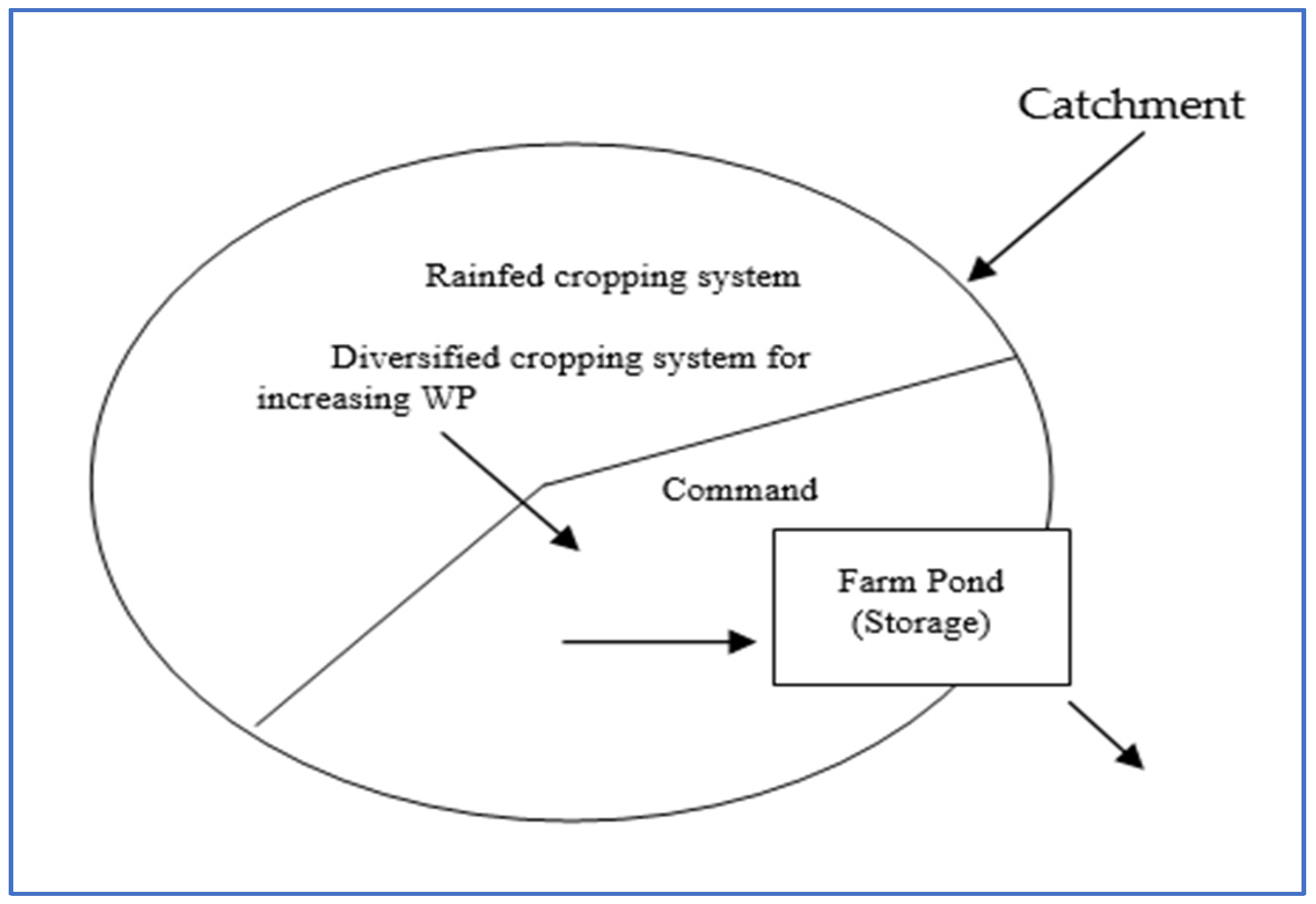
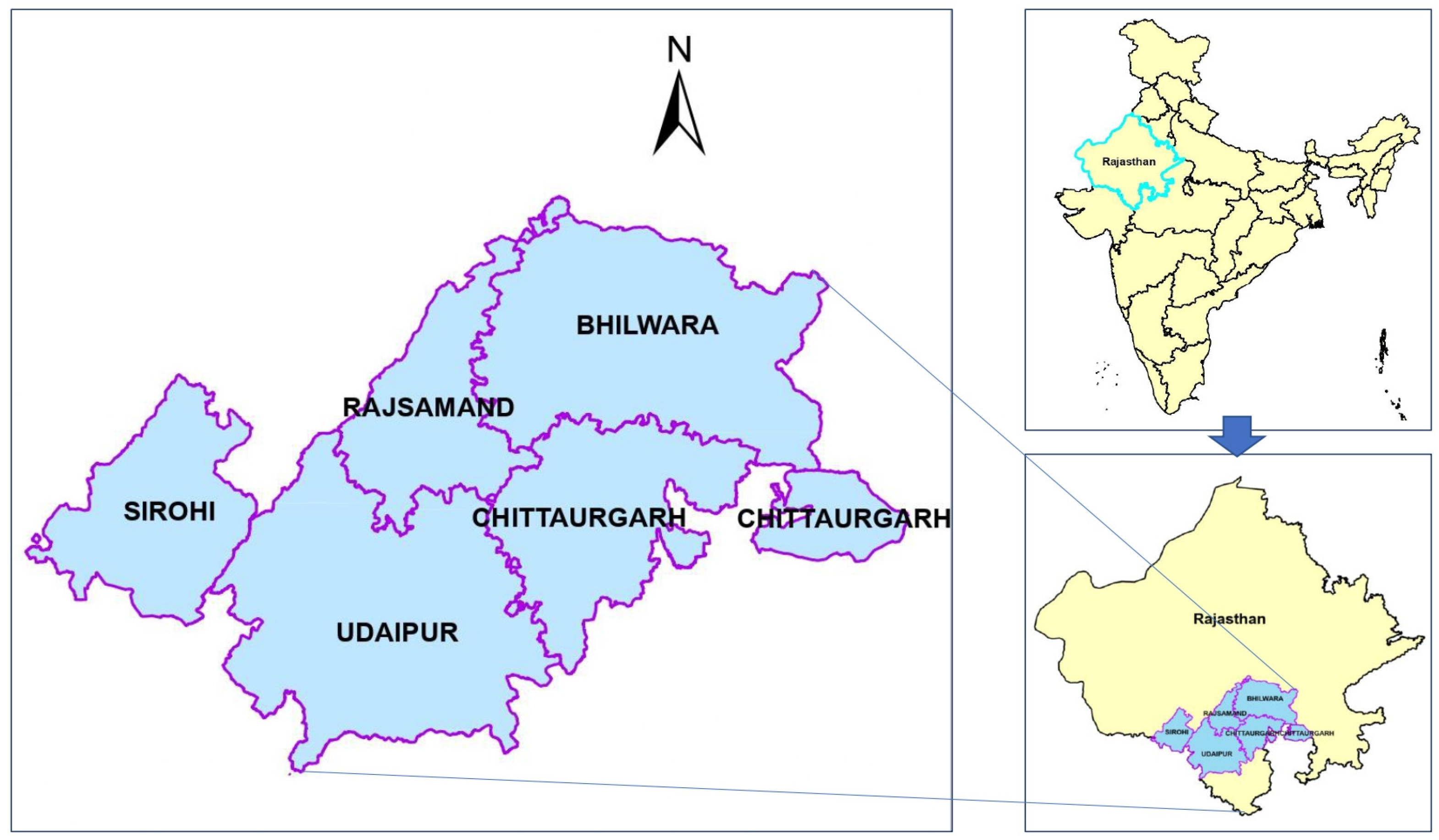
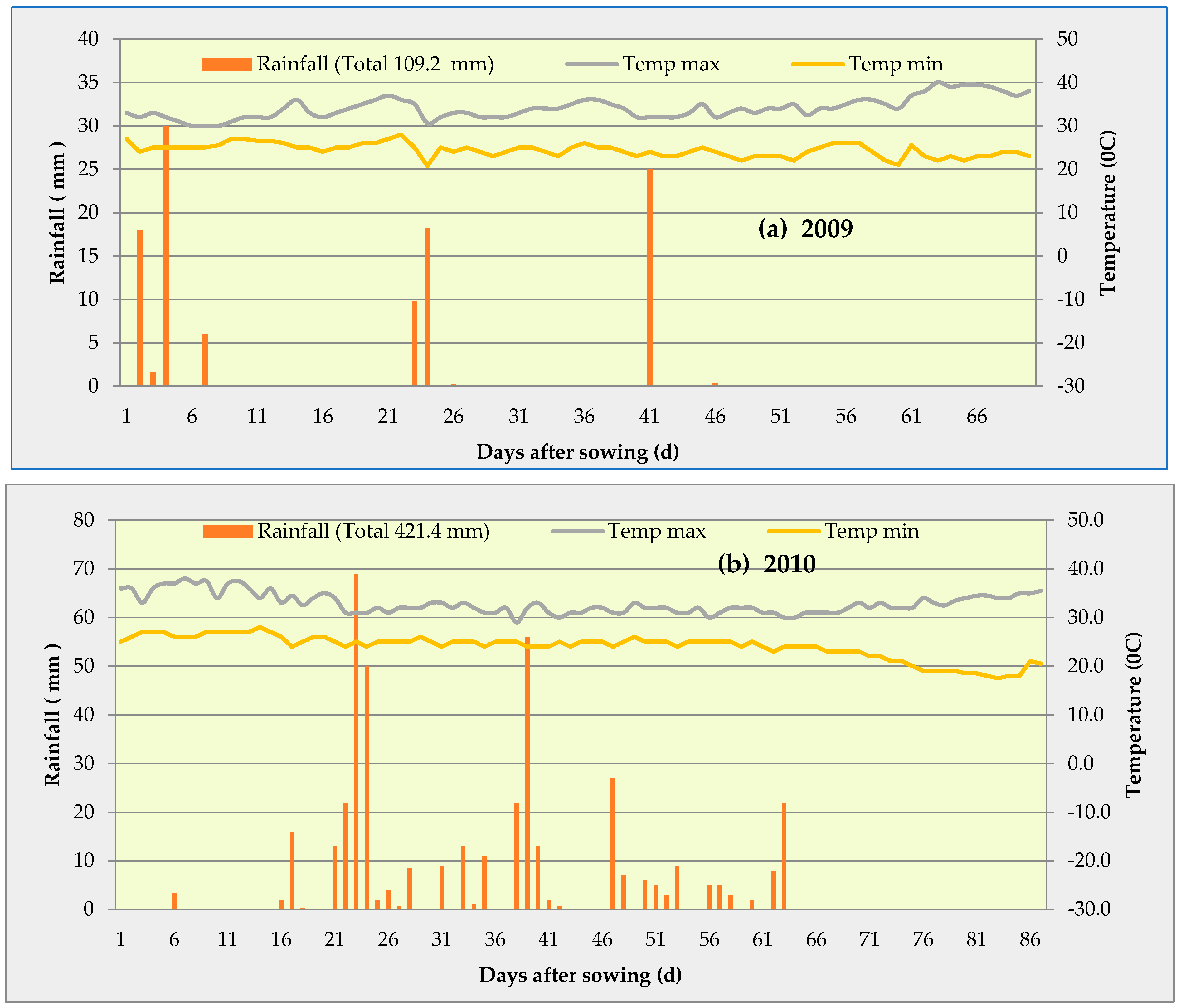
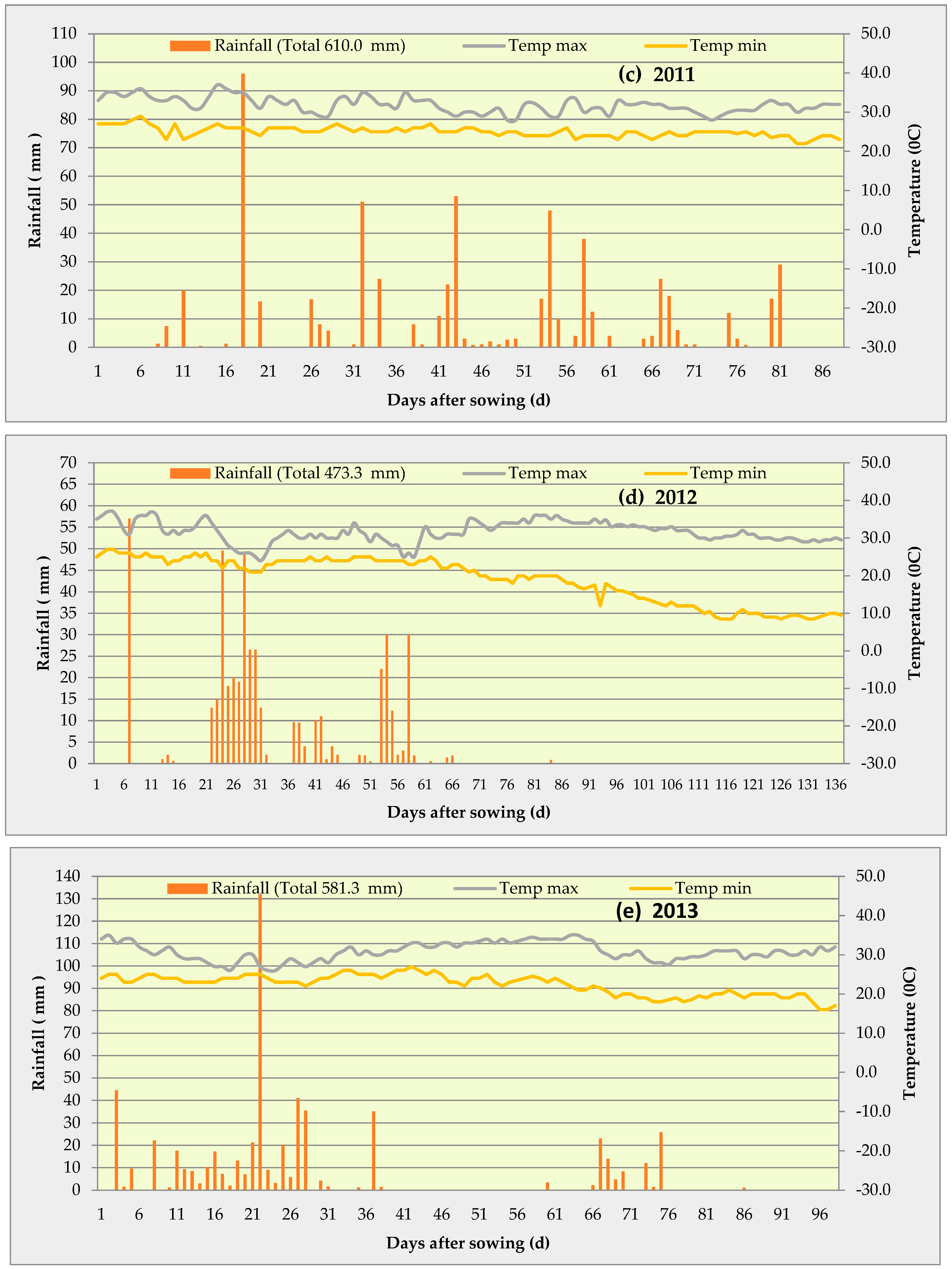
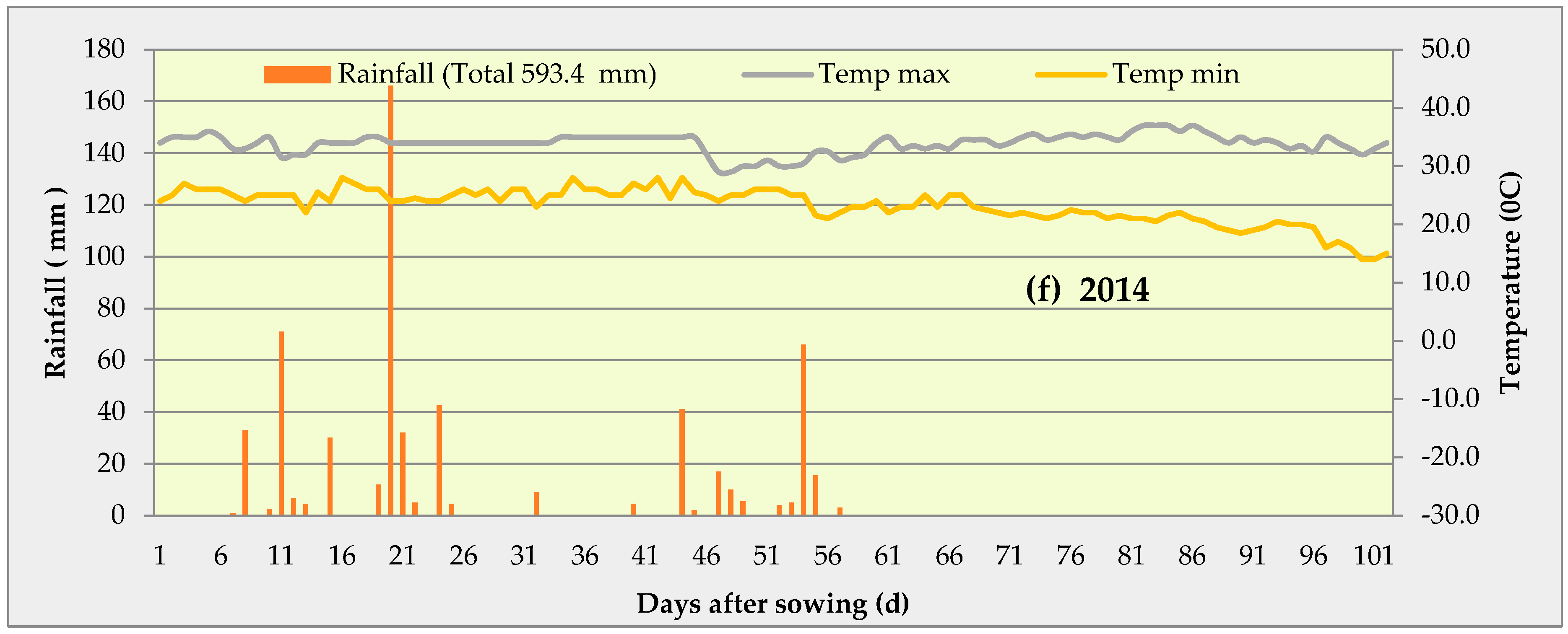
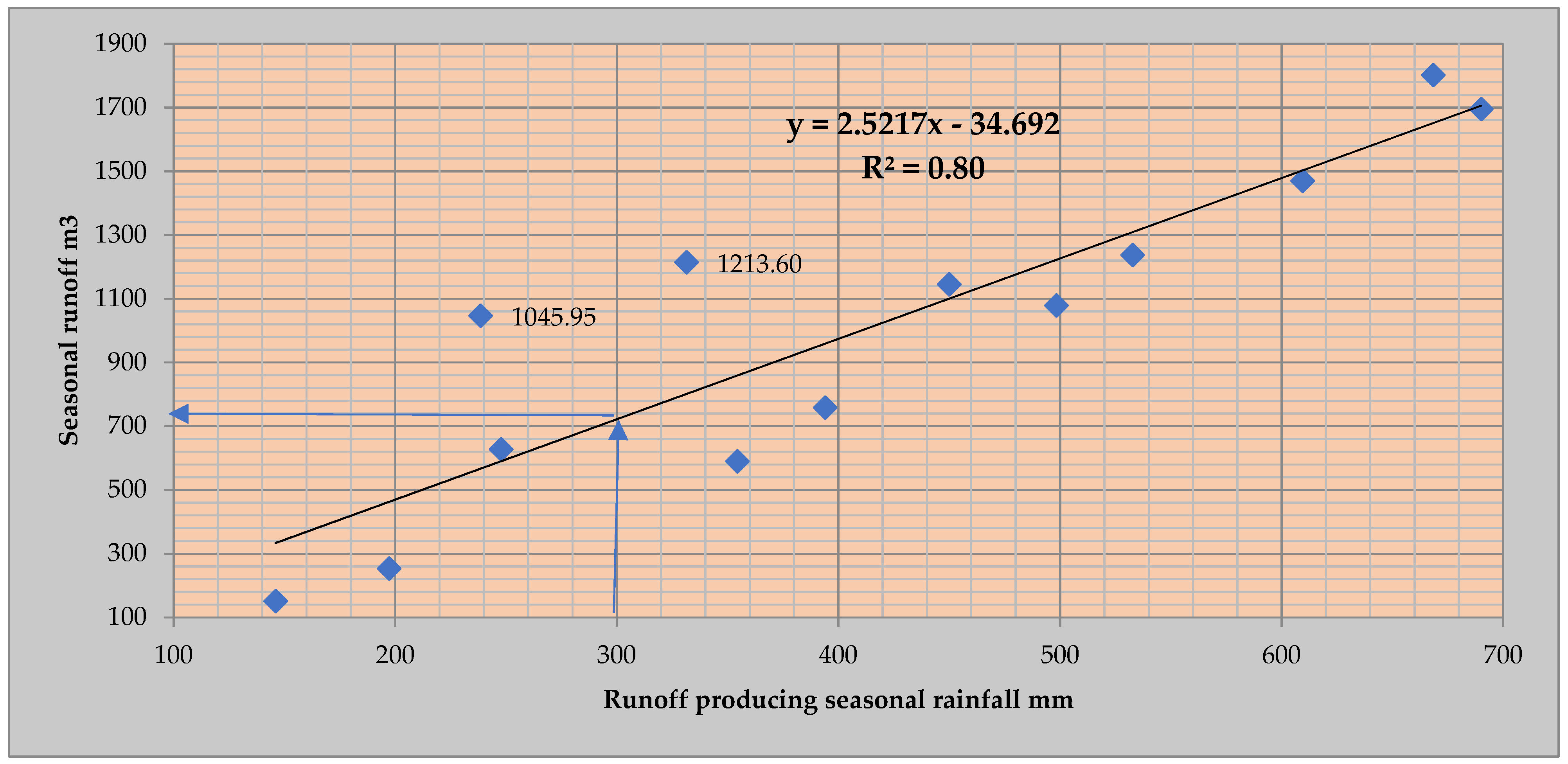
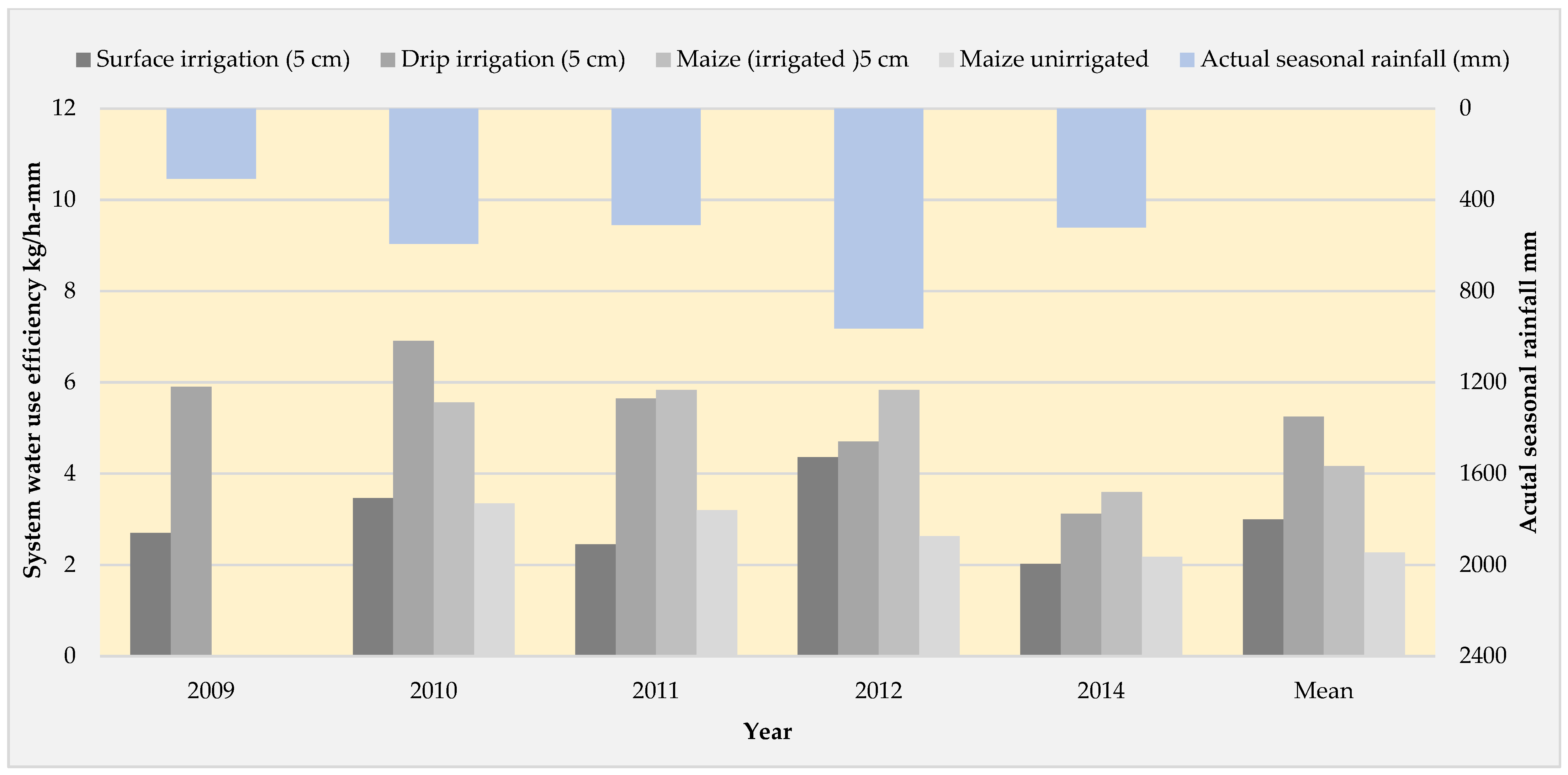
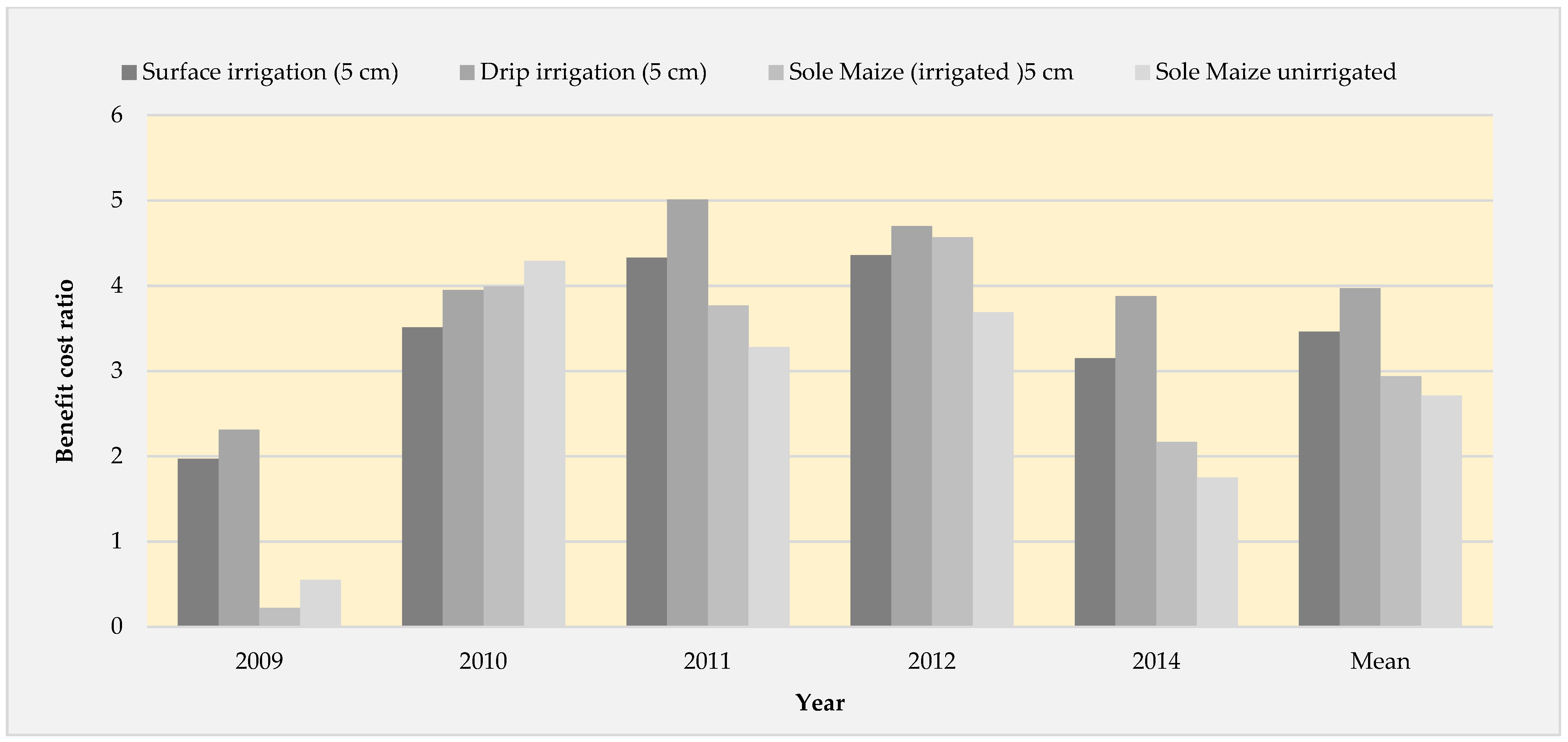
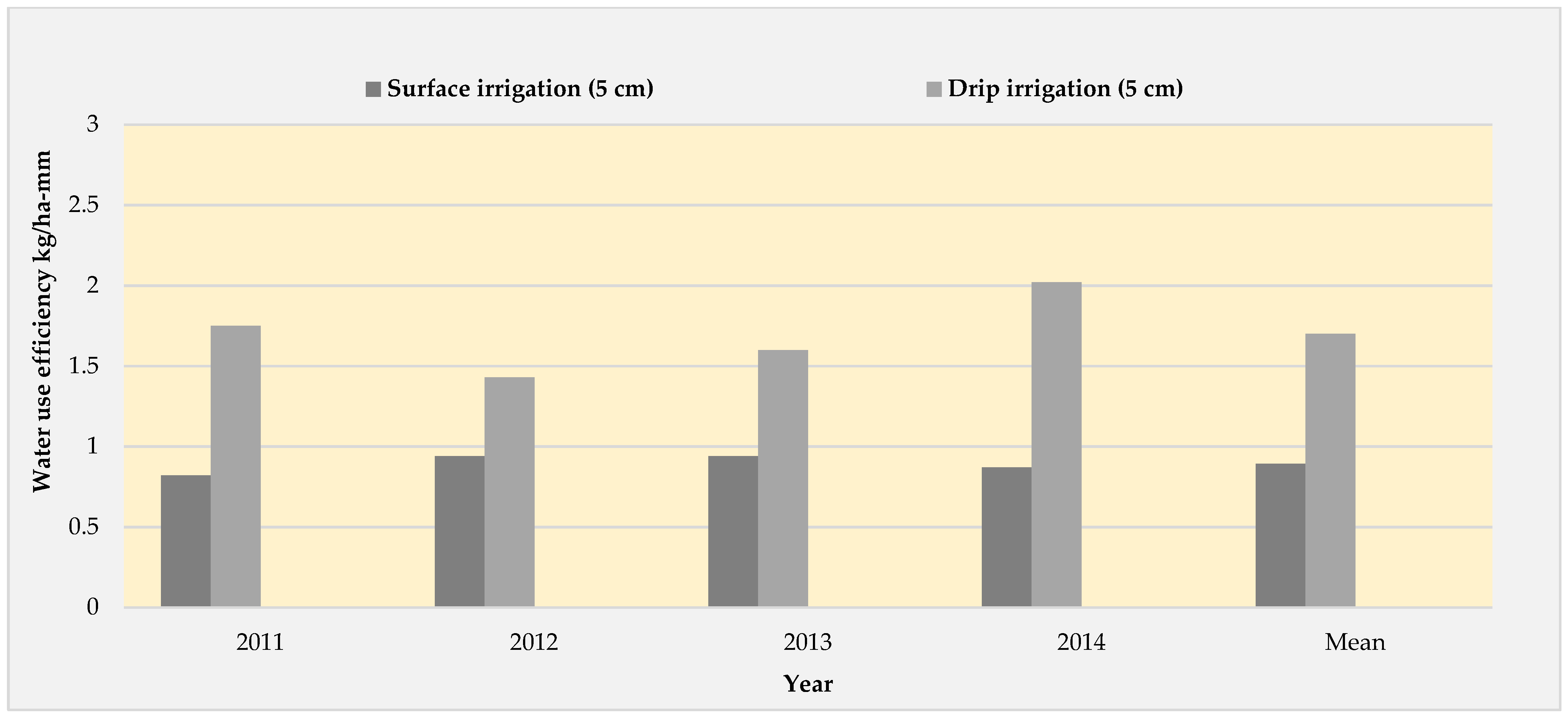

| S. No. | Depth cm | Sand % | Silt % | Clay % | Bulk Density (g/cm3) | WC mm/m | OMC % | PH | Available N (kg/ha) | Available P (kg/ha) | Available K (kg/ha) |
|---|---|---|---|---|---|---|---|---|---|---|---|
| 1 | 0–30 | 53.29 | 20.00 | 26.71 | 1.51 | 90 | 0.48 | 7.90 | 218 | 39.0 | 389 |
| 2 | 30–60 | 49.00 | 21.50 | 29.50 | 1.56 | 120 | 0.56 | 8.2 |
| S. No. | Characteristics | Value |
|---|---|---|
| 1 | Catchment area (ha) | 2.0 |
| 2 | Perimeter (m) | 544 |
| 3 | Maximum length (m) | 159 |
| 4 | Average width (m) | 115 |
| 5 | Shape index | 1.38 |
| 6 | Watershed relief (m) | 2.29 |
| 7 | Relief ratio | 0.02 |
| 8 | Relative relief | 0.004 |
| 9 | Elongation ratio | 0.74 |
| 10 | Compactness coefficient | 1.09 |
| 11 | Farm factor | 0.82 |
| 12 | Land management | Outward sloping |
| 13 | Landuse | Agriculture |
| S. No. | Months | Runoff-Producing Rainfall (mm) | ||||||||||||
|---|---|---|---|---|---|---|---|---|---|---|---|---|---|---|
| 1994 | 1996 | 1997 | 2004 | 2006 | 2007 | 2008 | 2009 | 2010 | 2011 | 2012 | 2013 | 2014 | ||
| 1 | June | 179.8 | 0 | 0 | 0 | 89 | 0 | 76 | 0 | 73 | 68 | 0 | 0 | 0 |
| 2 | July | 401.6 | 162.4 | 163 | 140 | 210 | 168.8 | 65 | 146 | 49 | 147 | 57 | 66.7 | 71 |
| 3 | August | 61 | 267.4 | 46.8 | 469.4 | 348 | 28.4 | 95 | 0 | 202 | 218.4 | 151.5 | 264.7 | 241 |
| 4 | September | 26 | 103 | 38 | 0 | 43 | 0 | 118.4 | 0 | 0 | 65 | 30 | 0 | 82 |
| 5 | October | 0 | 0 | 0 | 0 | 0 | 0 | 0 | 0 | 0 | 0 | 0 | 0 | 0 |
| 6 | November | 0 | 0 | 0 | 0 | 0 | 0 | 0 | 0 | 126 | 0 | 0 | 0 | 0 |
| 7 | December | 0 | 0 | 0 | 0 | 0 | 0 | 0 | 0 | 0 | 0 | 0 | 0 | 0 |
| Total | 668.4 | 532.8 | 247.8 | 609.4 | 690 | 197.2 | 354.4 | 146 | 450 | 498.4 | 238.5 | 331.4 | 390.00 | |
| S. No. | Months | Runoff (m3) | |||||||||||||
|---|---|---|---|---|---|---|---|---|---|---|---|---|---|---|---|
| 1994 | 1996 | 1997 | 2004 | 2006 | 2007 | 2008 | 2009 | 2010 | 2011 | 2012 | 2013 | 2014 | Mean | ||
| 1 | June | 386.01 | 0.00 | 0 | 0 | 197.75 | 0 | 155.80 | 0 | 149.65 | 111.52 | 0 | 0 | 0.00 | 76.98 |
| 2 | July | 1201.09 | 390.48 | 501.22 | 311.00 | 438.58 | 232.19 | 71.96 | 150.57 | 32.08 | 227.61 | 173.04 | 191.34 | 146.38 | 312.89 |
| 3 | August | 150.10 | 687.44 | 71.42 | 1157.95 | 969.85 | 20.38 | 126.58 | 0 | 662.77 | 565.58 | 797.44 | 1022.26 | 424.96 | 512.06 |
| 4 | September | 63.96 | 158.46 | 54.53 | 0 | 88.15 | 0 | 234.64 | 0 | 0 | 174.25 | 75.47 | 0 | 186.54 | 79.69 |
| 5 | October | 0 | 0 | 0 | 0 | 0 | 0 | 0 | 0 | 0 | 0 | 0 | 0 | 0.00 | 0.00 |
| 6 | November | 0 | 0 | 0 | 0 | 0 | 0 | 0 | 0 | 300.12 | 0 | 0 | 0 | 0.00 | 23.09 |
| 7 | December | 0 | 0 | 0 | 0 | 0 | 0 | 0 | 0 | 0 | 0 | 0 | 0 | 0.00 | 0.00 |
| Total | 1801.16 | 1236.38 | 627.17 | 1468.95 | 1694.33 | 252.57 | 588.98 | 150.57 | 1144.61 | 1078.96 | 1045.95 | 1213.60 | 757.88 | 1004.71 | |
| S.Em± | 40.29 | ||||||||||||||
| C.D (5%) | 113.58 | ||||||||||||||
| CV (%) | 130.50 | ||||||||||||||
| Normal seasonal rainfall (mm) | 626 | 626 | 626 | 615 | 614.5 | 614.5 | 614.5 | 611.5 | 611.5 | 611.9 | 611.9 | 614.5 | 614.5 | ||
| Actual seasonal rainfall (mm) | 1037.4 | 826 | 571.6 | 978.4 | 1032.8 | 520.4 | 633.5 | 306.8 | 593 | 509.7 | 963.8 | 747.2 | 521.6 | ||
| S. No | Year | Dry Spell Period | No. of Days | Stage of Crops in Maize | Stage of Crops (Vegetables) |
|---|---|---|---|---|---|
| 1 | 2009 | 28 July–11 August | 15 | Tasselling | Vegetative, flowering, and fruit/pod setting stages of vegetables |
| 2 | 16 August–29 August | 14 | Silking | ||
| 3 | 5 September–until withdrawal of monsoon | 35 + | Grain development | ||
| 4 | 2010 | 16 September–until withdrawal of monsoon | 25 + | Grain development | |
| 5 | 2011 | 19 September–until withdrawal of monsoon | 21 + | Grain development | |
| 6 | 2012 | 14 July–6 August | 24 | Vegetative | |
| 7 | 21 September–until withdrawal of monsoon | 19 + | Silking and grain development | ||
| 8 | 2013 | 26 August–15 September | 21 | Silking | |
| 9 | 2 October–until withdrawal of monsoon | 9 + | Grain development | ||
| 10 | 2014 | 1 July–9 July | 10 | Vegetative | |
| 11 | 20 August–26 August | 07 | Tasselling | ||
| 12 | 14 September–until withdrawal of monsoon | 26 + | Grain development |
| S. No. | Treatments | Maize Grain Equivalent Yield (kg/ha) | |||||
|---|---|---|---|---|---|---|---|
| 2009 | 2010 | 2011 | 2012 | 2014 | Mean | ||
| 1 | Sponge gourd | 0 | 6361 | 7767 | 5454 | 5054 | 4927 |
| 2 | Bottle gourd | 5321 | 5667 | 8125 | 6440 | 6284 | 6367 |
| 3 | Ridge gourd | 7916 | 8428 | 7097 | 6540 | 7098 | 7416 |
| 4 | Kachari (cucumber) | 8270 | 9231 | 9017 | 7120 | 8102 | 8348 |
| 5 | Veg cow pea | 3932 | 7655 | 6267 | 6650 | 6010 | 6103 |
| S.Em± | 283 | 449 | 386 | 95.5 | 411 | 622.24 | |
| C.D (at 5%) | 595 | 943 | 810 | 311.7 | 1340 | 1865.46 | |
| CV (%) | 20.98 | ||||||
| 1 | Surface irrigation (5 cm) | 4604 | 6934 | 7021 | 6126 | 3156 | 5568 |
| 2 | Drip irrigation (5 cm) | 5571 | 8003 | 8288 | 6755 | 3869 | 6497 |
| S.Em± | 127 | 201 | 172 | 23.15 | 132 | 82.45 | |
| C.D (at 5%) | 376 | 597 | 512 | 115.85 | 456 | 323.75 | |
| CV (%) | 3.06 | ||||||
| 1 | Maize (irrigated) 5 cm | 4789 * | 4547 | 4333 | 4082 | 2800 | 4110 |
| 2 | Maize unirrigated | 3433 * | 2850 | 2534 | 2241 | 1870 | 2586 |
| S.Em± | 121.15 | ||||||
| C.D (at 5%) | 475.70 | ||||||
| CV (%) | 8.09 | ||||||
| Normal seasonal rainfall (mm) | 611.5 | 611.5 | 611.9 | 611.9 | 614.5 | ||
| Actual seasonal rainfall (mm) | 306.8 | 593.0 | 509.7 | 963.8 | 521.6 | ||
| S. No. | Treatment | Pea Pod Equivalent Yield (kg/ha) | ||||
|---|---|---|---|---|---|---|
| 2011 | 2012 | 2013 | 2014 | Mean | ||
| Rabi Crops | ||||||
| 1 | Coriander green | 7083 | 5052 | 4547 | 4387 | 5267.25 |
| 2 | Pea pod | 5147 | 3801 | 3421 | 2817 | 3796.5 |
| 3 | Brinjal | 3733 | 4271 | 3844 | 3333 | 3795.25 |
| 4 | S.E m± | 400 | 66.89 | 60.20 | 145 | 329.76 |
| 5 | C.D at 5% | 892 | 262.61 | 236.35 | 569 | 1141.12 |
| CV(%) | 15.39 | |||||
| 6 | Surface irrigation | 5000 | 4143 | 3936 | 3156 | 4058.75 |
| 7 | Drip irrigation | 5822 | 4608 | 4378 | 3869 | 4669.25 |
| 8 | S.E m± | 400 | 20.13 | 19.12 | 132 | 66.08 |
| 9 | C.D at 5% | 892 | 100.74 | 95.7 | 456 | 297.41 |
| CV(%) | 3.03 | |||||
Disclaimer/Publisher’s Note: The statements, opinions and data contained in all publications are solely those of the individual author(s) and contributor(s) and not of MDPI and/or the editor(s). MDPI and/or the editor(s) disclaim responsibility for any injury to people or property resulting from any ideas, methods, instructions or products referred to in the content. |
© 2024 by the authors. Licensee MDPI, Basel, Switzerland. This article is an open access article distributed under the terms and conditions of the Creative Commons Attribution (CC BY) license (https://creativecommons.org/licenses/by/4.0/).
Share and Cite
Narsimlu, B.; Prasad, J.V.N.S.; Reddy, A.A.; Chary, G.R.; Gopinath, K.A.; Sridhar, K.B.; Balyan, J.K.; Kothari, A.K.; Singh, V.K. Catchment Storage Command Relationship for Sustainable Rainfed Agriculture in the Semi-Arid Regions of Rajasthan, India. Sustainability 2024, 16, 3996. https://doi.org/10.3390/su16103996
Narsimlu B, Prasad JVNS, Reddy AA, Chary GR, Gopinath KA, Sridhar KB, Balyan JK, Kothari AK, Singh VK. Catchment Storage Command Relationship for Sustainable Rainfed Agriculture in the Semi-Arid Regions of Rajasthan, India. Sustainability. 2024; 16(10):3996. https://doi.org/10.3390/su16103996
Chicago/Turabian StyleNarsimlu, Boini, J. V. N. S. Prasad, A. Amarender Reddy, Gajjala Ravindra Chary, Kodigal A. Gopinath, K. B. Sridhar, J. K. Balyan, Anil K. Kothari, and Vinod Kumar Singh. 2024. "Catchment Storage Command Relationship for Sustainable Rainfed Agriculture in the Semi-Arid Regions of Rajasthan, India" Sustainability 16, no. 10: 3996. https://doi.org/10.3390/su16103996






